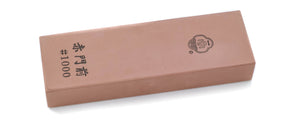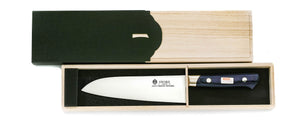Introduction to Japanese Kitchen Knives Part 2: Types of Steel
Welcome to Part 2 of our "How to Choose a Japanese Knife" series. This is the second entry in a four part series, and while it can be read independently, you can find the first part here!
At this stage we have looked at whether you should get a forged or stamped knife, as well as the blade length and region you are looking for.
This part will cover how to choose the steel type is best for you.
Let's continue helping you discover your knife recipe! Remember, as per Part 1 we are looking at chef's knives.
We will be mentioning many kinds of steel today, and we have articles written on almost all of them seperately going into more scientific breakdowns. You can read all those here in our Japanese Knife Steel Guide.
Aren't all knives steel knives?
Most Japanese knives are made of steel, but not all. You can find knives made out of material like ceramic as well.
For this series, we are only going to look at steel. It's what we're experts in, and what all our knives are made of! The knives you have at home may be steel already, but the kind of steel it is might be very different. A general store or supermarket knife that is mass-produced will use a totally different steel to a high-end knife made by an artisan in a forge by hand.
There is more than just one kind of steel though, and it is an important part of your knifemaking decision. Steels come with their own advantages and disadvantages, and it's important to get one that matches your requirements.
What kinds of steel are used in Japanese kitchen knives?
Let's define what steel is. Steel at it's simplest, is iron mixed with small amounts of carbon. The carbon strengthens and toughens the iron. This steel composition is further modified to make a steel type.
Thousands of steel types exist for machinery, cooking and so on. In Japan, kitchen knives mostly use high-carbon steel and stainless steel.
High-carbon steel has few impurities or additions. It's high-performance and inexpensive, but prone to rusting without proper care. Other minor metals like tungsten and vanadium may be added in trace amounts to increase durability.
If the steel is at least 10.5% chromium, and under 1.2% carbon, it's called high-carbon stainless steel or stainless steel for short. Chromium prevents rust, but is also a minor metal, which increases the steel's cost.
The steels used in Japan are relatively hard, often more so than steels from other countries. A steel that is harder can be made sharper with proper treatment and maintenance, and also keep its edge for longer. We have an article dedicated to how hardness is measured here!
The Common Carbon Steels in Japanese Knives
Japanese manufacturers produce many different high-carbon steels for kitchen knives. Here's the most common ones you'll find.
SK4 Steel is the baseline for carbon steel in Japan. It is incredibly afforable and easy to sharpen, but has larger amounts of sulfur and phosphorus which makes this steel brittle.
White Steel #1 and White Steel #2 are very hard and thus can be made very sharp, closely resembling tamahagane - traditional Japanese sword steel. These are pure steels, with no additions and many impurities removed, making them easier steels to sharpen and produce. #1 is harder than #2 as it contains a higher percentage of carbon.
Blue Steel #1 and Blue Steel #2 are alloy steels. Effectively, they are White Steel with extras like tungsten added to improve performance and lifespan. Blue Steel have a smooth cutting experience and hold an edge for longer, yet cost more due to the inclusion of minor metals.
Blue Steel Super takes this further, adding vanadium and even more tungsten, which allows for more carbon to be added. This is the pinnacle of high-carbon steel, but is expensive and needs careful use.
If you value hardness, Blue Steel Super is the hardest carbon steel, followed by White Steel #1.
If you value ease of sharpening, we recommend White Steel #2, Blue Steel #2, or White Steel #1.
If you're an experienced chef and want your first Japanese knife, we recommend Blue Steel #1 or Blue Steel Super.
The Common Stainless Steels in Japanese Knives
There's even more stainless steel types out there than carbon steel ones, as the chromium allows for significantly more variance. Here's just some of what we use.
VG-1 and VG-10 are made by Takefu Special Steel in Gifu Prefecture. These steels are both as hard as some carbon steels, yet also offer strong rust resistance provided they are forged well. VG-10 is an evolution of VG-1, including the minor metal cobalt to improve durability at an added cost. These stainless steels have a particular focus on sharpness and edge retention. Infact, they are both as hard as eachother - and only slightly less hard than White Steel #2.
AUS-6, AUS-8 and AUS-10 are made by Aichi Metals in Aichi Prefecture. These steels are a little less hard, but are more durable and easier to re-sharpen. The higher numbered series have more carbon in them. Infact, AUS-10 has more carbon than VG-10, and is only slightly less hard.
If you solely value hardness, AUS-10 is the hardest steel, followed by either VG-1 or VG-10. Or, try SG2/R2 (covered later!)
If you value ease of sharpening, we recommend AUS-8 or VG-1, but VG-10 will also work.
If you're an experienced chef and want your first Japanese knife, we recommend AUS-10 or VG-10. Or, try Silver Steel #3 (covered later!)
Are there other steels too? Is it important?
Sub-categories of carbon steel and stainless steel exist as well. Some of the types you'll find are semi-stainless steel and High Speed Powdered Tool Steel, often called high speed steel in Japan. The steels are still either carbon or stainless steels, they just also may have one or both of these extra qualifiers. For example, ZDP-189 steel is a carbon semi-stainless high speed steel - it has both!
A steel might get the nickname of being semi-stainless if it falls under one of the three conditions below:
Chromium is added above trace levels, but less than 10.5%: Tokko Steel and Chromax Steel fit this
Chromium added is over 10.5%, but carbon added is also over 1.2%: ZDP-189 fits this
Chromium over 10.5%, carbon under 1.2%, but missing most other minor metals: Silver Steel #3 fits this
Silver Steel #3, also called Ginsan is a bit of a unique steel, so let's talk about it more. It has 1.025% carbon on average and over 10.5% chromium. By standard appearance, that's a stainless steel and technically it is one! But it is missing other elements which a stainless steel normally has - Ginsan has no molybdenum, nickel, vanadium, or tungsten. So, as it's not like other stainless steels which all have those, it's called semi-stainless by some. Semi-stainless is more of a knifemaking community nickname, so the rules are flexible.
High Speed Powdered Tool Steel is steel made via a technique called powder mettalurgy. Raw elements are broken down into a fine powder, then fused together at precise quantities in a vacuum furnace. This creates a very measured steel with low impurities. ZDP-189, SG2 (also called Super Gold 2,) and R2 are stainless examples of this, and HAP-40 and ZDP-189 are high-carbon examples.
The choice of steel is an important one. Generally, a high-carbon steel knife will outperform a stainless steel one if their price is the same. The rust resistance is important though, and cannot be understated. If you live in a humid environment, or near salty water like at a beach, it's especially crucial. It's also important to remember a high quality stainless steel knife is still a high quality knife. It just also resists rust!
There's other factors you can also consider such as grain structure, but for learning how to choose your possibly knife we feel that's a little overloading. Even the above we feel is a little much! Be aware other factors exist, but only dive into those if you want to become more of an enthusiast.
This is the end of Part 2! Now, you should be able to decide what major category of steel you want your knife to be made of. Let's update our knife recipe:
I want a forged Japanese chef's knife made in Sakai, Japan, that has a blade length of 240mm, and is made of VG-10 stainless steel.
Material alone does not determine performance though. Heat treatment, tempering and sharpening all impact the knife too, and we believe it is the most important step. It's the topic of our next article, so check out Part 3 if you want to learn more about how Japanese knives are made.































